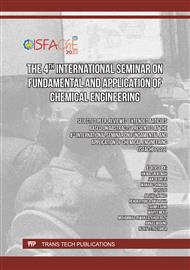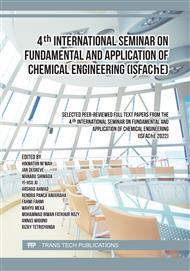[1]
A.L. Ahmad, M.F. Chong, S. Bhatia, A comparative study on the membrane based palm oil mill effluent (POME) treatment plant, Journal of Hazardous Materials. 171 (2009) 166–174.
DOI: 10.1016/j.jhazmat.2009.05.114
Google Scholar
[2]
M.A. Ngan, novel treatment process for palm oil mill effluent, Ministry of Primary Industries, Malaysia, 1996. https://scholar.google.com/scholar_lookup?title=novel+treatment+process+for+palm+oil+mill+effluent&author=Ngan%2C+Ma+Ah.&publication_year=1996 (accessed October 6, 2022).
DOI: 10.1016/s0273-1223(96)00828-1
Google Scholar
[3]
M. Nasrullah, L. Singh, Z. Mohamad, S. Norsita, S. Krishnan, N. Wahida, A.W. Zularisam, Treatment of palm oil mill effluent by electrocoagulation with presence of hydrogen peroxide as oxidizing agent and polialuminum chloride as coagulant-aid, Water Resources and Industry. 17 (2017) 7–10.
DOI: 10.1016/j.wri.2016.11.001
Google Scholar
[4]
Y.J. Chan, W.J.R. Tan, B.S. How, J.J. Lee, V.Y. Lau, Fuzzy optimisation approach on the treatment of palm oil mill effluent (POME) via up-flow anaerobic sludge blanket–hollow centered packed bed (UASB–HCPB) reactor, Journal of Water Process Engineering. C (2015) 112–117.
DOI: 10.1016/j.jwpe.2015.01.005
Google Scholar
[5]
K. Vijayaraghavan, D. Ahmad, M. Ezani Bin Abdul Aziz, Aerobic treatment of palm oil mill effluent, J Environ Manage. 82 (2007) 24–31.
DOI: 10.1016/j.jenvman.2005.11.016
Google Scholar
[6]
R. Del Pozo, V. Diez, Organic matter removal in combined anaerobic-aerobic fixed-film bioreactors, Water Res. 37 (2003) 3561–3568.
DOI: 10.1016/S0043-1354(03)00273-2
Google Scholar
[7]
L. Singh, Z.A. Wahid, M.F. Siddiqui, A. Ahmad, M.H. Ab. Rahim, M. Sakinah, Application of immobilized upflow anaerobic sludge blanket reactor using Clostridium LS2 for enhanced biohydrogen production and treatment efficiency of palm oil mill effluent, International Journal of Hydrogen Energy. 38 (2013) 2221–2229.
DOI: 10.1016/j.ijhydene.2012.12.004
Google Scholar
[8]
A.L. Ahmad, S. Sumathi, B.H. Hameed, Coagulation of residue oil and suspended solid in palm oil mill effluent by chitosan, alum and PAC, Chemical Engineering Journal. 118 (2006) 99–105.
DOI: 10.1016/j.cej.2006.02.001
Google Scholar
[9]
A. Fakhru'l-Razi, M.J.M.M. Noor, Treatment of palm oil mill effluent (POME) with the membrane anaerobic system (MAS), Water Science and Technology. 39 (1999) 159–163.
DOI: 10.1016/S0273-1223(99)00268-1
Google Scholar
[10]
A.A.L. Zinatizadeh, A.R. Mohamed, M.D. Mashitah, A.Z. Abdullah, M.H. Isa, Optimization of pre-treated palm oil mill effluent digestion in an up-flow anaerobic sludge fixed film bioreactor: A comparative study, Biochemical Engineering Journal. 35 (2007) 226–237.
DOI: 10.1016/j.bej.2007.01.018
Google Scholar
[11]
M. Nasrullah, A.W. Zularisam, S. Krishnan, M. Sakinah, L. Singh, Y.W. Fen, High performance electrocoagulation process in treating palm oil mill effluent using high current intensity application, Chinese Journal of Chemical Engineering. 27 (2019) 208–217.
DOI: 10.1016/j.cjche.2018.07.021
Google Scholar
[12]
M. Nasrullah, L. Singh, Z.A. Wahid, Treatment of Sewage by Electrocoagulation and the Effect of High Current Density, (2012) 5.
Google Scholar
[13]
B. Merzouk, B. Gourich, A. Sekki, K. Madani, Ch. Vial, M. Barkaoui, Studies on the decolorization of textile dye wastewater by continuous electrocoagulation process, Chemical Engineering Journal. 149 (2009) 207–214.
DOI: 10.1016/j.cej.2008.10.018
Google Scholar
[14]
B. Merzouk, B. Gourich, K. Madani, Ch. Vial, A. Sekki, Removal of a disperse red dye from synthetic wastewater by chemical coagulation and continuous electrocoagulation. A comparative study, Desalination. 272 (2011) 246–253.
DOI: 10.1016/j.desal.2011.01.029
Google Scholar
[15]
F. Hanafi, O. Assobhei, M. Mountadar, Detoxification and discoloration of Moroccan olive mill wastewater by electrocoagulation, Journal of Hazardous Materials. 174 (2010) 807–812.
DOI: 10.1016/j.jhazmat.2009.09.124
Google Scholar
[16]
M. Zaied, N. Bellakhal, Electrocoagulation treatment of black liquor from paper industry, Journal of Hazardous Materials. 163 (2009) 995–1000. https://doi.org/10.1016/j.jhazmat. 2008.07.115.
DOI: 10.1016/j.jhazmat.2008.07.115
Google Scholar
[17]
A. Nasution, B.L. Ng, E. Ali, Z. Yaakob, S.K. Kamarudin, Electrocoagulation of Palm Oil Mill Effluent for Treatment and Hydrogen Production Using Response Surface Methodology, Pol. J. Environ. Stud. 23 (n.d.) 1669–1677.
DOI: 10.2134/jeq2011.0002
Google Scholar
[18]
M.B. Agustin, W.P. Sengpracha, W. Phutdhawong, Electrocoagulation of Palm Oil Mill Effluent, International Journal of Environmental Research and Public Health. 5 (2008) 177–180.
DOI: 10.3390/ijerph5030177
Google Scholar
[19]
J.N. Hakizimana, B. Gourich, M. Chafi, Y. Stiriba, C. Vial, P. Drogui, J. Naja, Electrocoagulation process in water treatment: A review of electrocoagulation modeling approaches, Desalination. 404 (2017) 1–21.
DOI: 10.1016/j.desal.2016.10.011
Google Scholar
[20]
D. Ghosh, H. Solanki, M.K. Purkait, Removal of Fe(II) from tap water by electrocoagulation technique, Journal of Hazardous Materials. 155 (2008) 135–143.
DOI: 10.1016/j.jhazmat.2007.11.042
Google Scholar
[21]
O. Larue, E. Vorobiev, C. Vu, B. Durand, Electrocoagulation and coagulation by iron of latex particles in aqueous suspensions, Separation and Purification Technology. 31 (2003) 177–192.
DOI: 10.1016/S1383-5866(02)00182-X
Google Scholar
[22]
A. Tahreen, M.S. Jami, F. Ali, Role of electrocoagulation in wastewater treatment: A developmental review, Journal of Water Process Engineering. 37 (2020) 101440.
DOI: 10.1016/j.jwpe.2020.101440
Google Scholar
[23]
P. Drogui, M. Asselin, S.K. Brar, H. Benmoussa, J.-F. Blais, Electrochemical removal of pollutants from agro-industry wastewaters, Separation and Purification Technology. 61 (2008) 301–310.
DOI: 10.1016/j.seppur.2007.10.013
Google Scholar
[24]
J. Duan, J. Gregory, Coagulation by hydrolysing metal salts, Advances in Colloid and Interface Science. 100–102 (2003) 475–502.
DOI: 10.1016/S0001-8686(02)00067-2
Google Scholar
[25]
A.H. Essadki, M. Bennajah, B. Gourich, Ch. Vial, M. Azzi, H. Delmas, Electrocoagulation/electroflotation in an external-loop airlift reactor—Application to the decolorization of textile dye wastewater: A case study, Chemical Engineering and Processing: Process Intensification. 47 (2008) 1211–1223.
DOI: 10.1016/j.cep.2007.03.013
Google Scholar



